EMBODIED CARBON
How to talk to clients about ambitious environmental targets and get their buy-in.
By katharine Logan
The Conversation

CLIENTS AND CLIMATE
Photography © Fred Joe
The degree to which an architect can mitigate the climate impacts of a building often depends on the degree to which that building’s owner is on board. Clients vary, of course, and some are going to be more open than others to the idea of doing whatever it takes to help preserve a livable planet. But if a client is at least agnostic, a conversation can make the difference between, say, an affordable-housing project that addresses emergency needs with a gas-powered generator and one that uses battery-stored solar while also reducing residents’ energy bills. Or the difference between a project that minimizes its embodied carbon and one that offsets it. So how are firms with ambitious climate commitments navigating these client discussions? What strategies are making a difference?
The St. Peter Apartments, a $7.4 million, 45,000-square-foot affordable-housing complex in New Orleans (completed in 2020), didn’t start out targeting net zero energy. The achievement grew in response to a concern expressed by the client, SBP (a national non-profit), about buffering vulnerable residents against the city’s frequent power outages. “On every project, owners have this little question that they ask,” says Z Smith, director of sustainability and building performance at locally based EskewDumezRipple (EDR), the project’s architect, “and if you see it, that question is an opportunity.”
On St. Peter, the little question was, “Could you look into batteries?” Instead of suggesting that a gas-powered generator would be cheaper, EDR showed the client that investing in more energy-efficient construction would reduce consumption needs to the point where rooftop solar panels could supply the building’s power—and charge a battery array too. The development’s investors would be able to access solar tax credits, with the price of the batteries rolled in, and the resulting system would not only provide backup power, it would cut residents’ bills substantially. As it turned out, the local utility was so intrigued with the idea of a microgrid (a self-contained power system that’s capable of operating autonomously when disconnected from the main grid) at such a small scale that they pitched in $1 million, and the solar system for Louisiana’s first net zero energy affordable-housing development ended up costing the owner nothing.
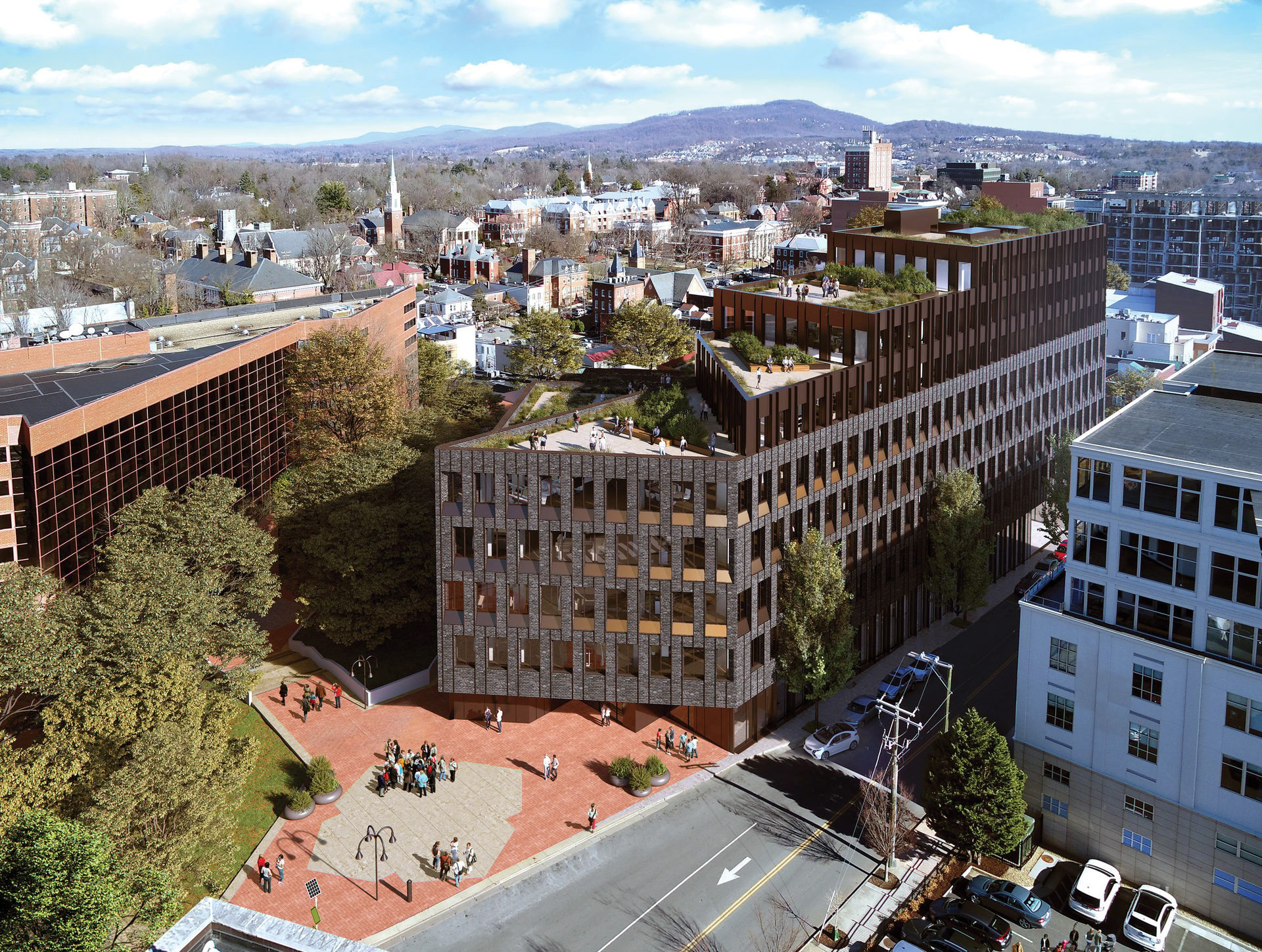
In Charlottesville, Virginia, the Center of Developing Entrepreneurs, designed by EskewDumezRipple, will source clean energy from a new wind project off the state's coast.
Photography © EskewDumezRipple
Similarly, another EDR project, the Center of Developing Entrepreneurs, a 215,000-square-foot technology center comprising coworking, makerspaces, laboratory, and office uses that will be completed this year in downtown Charlottesville, Virginia, didn’t start out targeting LEED Platinum, or planning to use only carbon-free energy, or intending to offset its embodied-carbon footprint. Those achievements grew out of a series of conversations between EDR and the project’s owner, CSH Development. EDR pointed out that the building they had designed in accordance with the AIA’s Framework for Design Excellence—to satisfy a desire expressed by CSH’s president to be able to open a window and feel the breeze—would probably qualify for LEED Platinum. “And the client said, ‘Well, talk to my marketing people and see if they want to do that,’ and they did,” says Smith. Then EDR pointed out that since the building’s energy was projected to cost only $113,000 per year, compared to the $400,000 that a merely code-compliant building would pay, an extra $6,000 was a small price to pay to source carbon-free energy from a new wind project off the Virginia coast. And the client agreed—which just left the burp of carbon from the building’s construction. So EDR initiated another conversation, pointing out that half of Charlottesville enjoyed beautiful tree cover, and the other half, primarily in historically African-American neighborhoods, was bare. A modest contribution to a local urban forestry nonprofit would pay for the planting and maintenance of enough trees to suck out of the atmosphere all of the carbon that making the building would emit. “It’s all about how you approach the conversations,” says Smith. “What matters is the willingness to have them. The client doesn’t have to sign up for everything, but you do make the case.”
The Seattle- and San Diego–based Miller Hull Partnership talks about sustainability in a similarly incremental way, framed by the firm’s explicit climate commitment. In 2021, Miller Hull launched its EMission Zero initiative, aimed at eliminating greenhouse-gas emissions from all of its projects through a three-pronged program of design, education and advocacy, and offsetting. “EMission Zero has given us a framework for having discussions with our clients on both Scope 2 (operational) emissions and Scope 3 (embodied) emissions,” says Ron Rochon, a partner in the firm’s Seattle office, “and we're finding that both our institutional and commercial clients are excited to engage.”
For Scope 2, “we always start from the premise that where our client is meeting us is good design,” says Rochon. Then, for every project, the firm performs what it calls a gap analysis to show what would be needed to move the project from good to better, and from better to best. “Better” is a reduced-carbon design that meets the requirements of the AIA 2030 Commitment (consisting of stepped reductions towards carbon-neutral building operations by 2030), and “best” is a regenerative project that meets the stringent requirements of the Living Building Challenge. The gap analysis conversation—which Rochon says clients welcome because they want to see what the possibilities are—covers the concepts underlying each scenario, and puts the construction-cost premium in the context of operational savings. And while not every client chooses to level up, “if we can move them a step,” says Rochon, “that’s a huge success.”
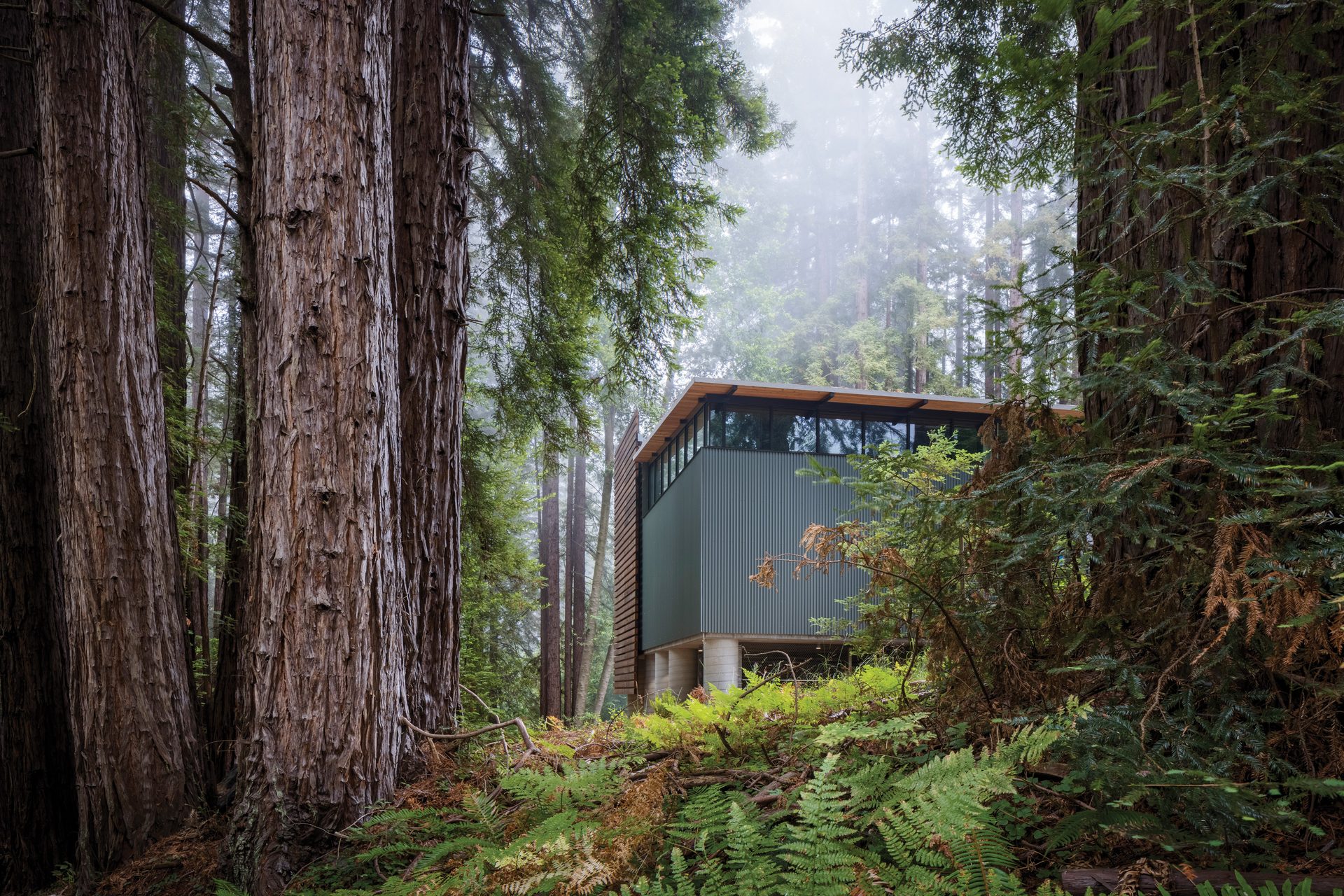
Miller Hull has purchased carbon offsets for its Environmental Health & Safety Facility at the University of California Santa Cruz.
Photography © chipper Hatter
Another conversation that Miller Hull holds with both the client and the contractor pertains to offsetting embodied emissions. “By doing design for clients, Miller Hull is a contributor to embodied-carbon emissions,” says Rochon, so for every project completed, the firm purchases certified carbon offsets. (A carbon offset is a tradable unit that represents 1 metric ton of CO₂ equivalent that a mitigation project—such as a sustainably managed forest or a wind-energy farm—has removed from the atmosphere or prevented from being released in the first place.) Miller Hull’s goal is to completely offset each of its projects’ embodied carbon as of the occupancy date, calculated using the Tally life cycle assessment tool. Ideally, the architect, contractor, and client will each offset a third of the total, but, “regardless of what our clients or contractors are willing to do,” says Rochon, “we offset our third anyway.”
The firm’s offsets for seven projects substantially completed in 2021 accounted for 16,678 metric tons of carbon dioxide equivalents (tCO₂e). The projects range in type and scale, including the University of California Santa Cruz Environmental Health & Safety Facility (total up-front impact: 620 tCO₂e), the new U.S. embassy in Niamey, Niger (13,729 tCO₂e), and a commercial building in Seattle, 333 Dexter (30,025 tCO₂e). With offsets currently costing in the range of $8 to $10 per metric ton, Rochon says clients are generally surprised to find that the total cost of offsetting compared to the total cost of a project is tiny. “When clients see what we have already done on past projects, and what we are going to do on their project, they become very receptive to the idea,” he says. “I’m just hoping we can show people that this is a cool and unique thing to do, and that our clients understand that it makes them different in the market place.”
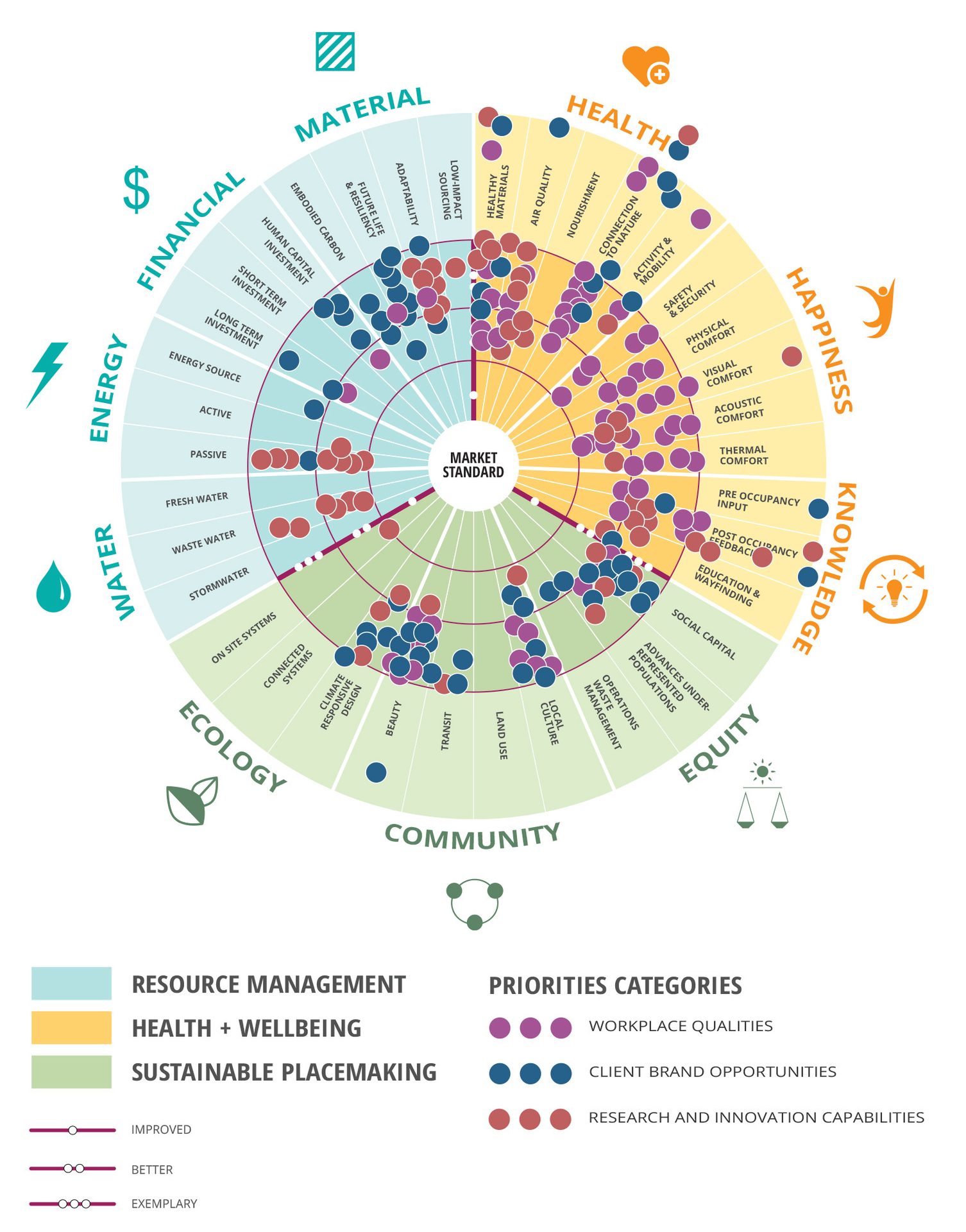
Somewhere between EDR’s cumulative, narrative-based strategy and Miller Hull’s structured framework is SERA Architects’ low-tech (in a good way) graphic tool, called “project compass,” that the firm developed to guide the setting of priorities. “It provides a nuanced approach that’s helpful both internally and for clients of varying levels of sophistication, who may not understand what’s achievable,” says Clark Brockman, a principal in SERA’s Portland office.
The compass provides a holistic picture of 36 potential priorities organized into three sectors: resource management, sustainable placemaking, and health and well-being. A circle at the center of the compass represents the market standard for the project location and type, with three concentric rings representing successive levels of improvement. Priorities can be expressed on the compass in a variety of ways: projects with larger constituencies sometimes use dots on the compass to indicate participants’ “votes” on where the project should position itself, and then translate the dots into a cell or spider diagram that summarizes the aspirations.
As part of a goal-setting charrette, SERA used its project compass to establish the priorities for the design of its own office in Portland, Oregon.
The project compass then informs the next stage: the articulation of key performance goals, which may be expressed in a project charter and/or in terms of the Five Capitals Model. (Five Capitals is a framework for sustainability developed by the international nonprofit Forum for the Future. It expands the understanding of wealth creation beyond physical and financial capital to include human, natural, and social capital.) “We’ve tried to tune our strategies and goals within each market sector to align with what’s possible,” says Brockman. “That way, teams can feel they’re working toward something that is both impactful and achievable.”
Beyond establishing nuanced goals project by project, SERA is working to refocus two larger conversations, both with clients and within the profession as a whole. The first pertains to net zero versus absolute zero. The problem with net zero—which allows a project to give and take energy from the grid over the course of a year (as long as it gives at least as much as it takes)—is that it places the burden of storing the project’s surpluses and supplying its deficits on the transmission grid and the utilities, says Mark Perepelitza, SERA’s director of sustainability. “If you had a zero-carbon focus instead, you would find ways to store clean energy, to make sure more buildings are using it at times when the grid is otherwise dirty,” which typically occur during periods of peak demand.
The second refocusing seeks to center the conversation around carbon, regardless of source, rather than energy. “It took the industry over 15 years to home in on net zero as a big goal. Now we’re going to have to shift it again—including the certifications and the reward mechanisms,” says Brockman. “We don’t need to throw away what we did with net zero,” he adds. “We just have to take the discussion farther and deeper.”
Placing client conversations in the context of evolving industry issues is something Cannon Design is also doing. The firm’s news-clipping service, for example, highlights climate-related trends in five categories—the regulatory landscape, insurance, shareholders, transparency, and credit risk—that have potential implications for development, and distributes the collected industry insights to clients and staff each quarter.
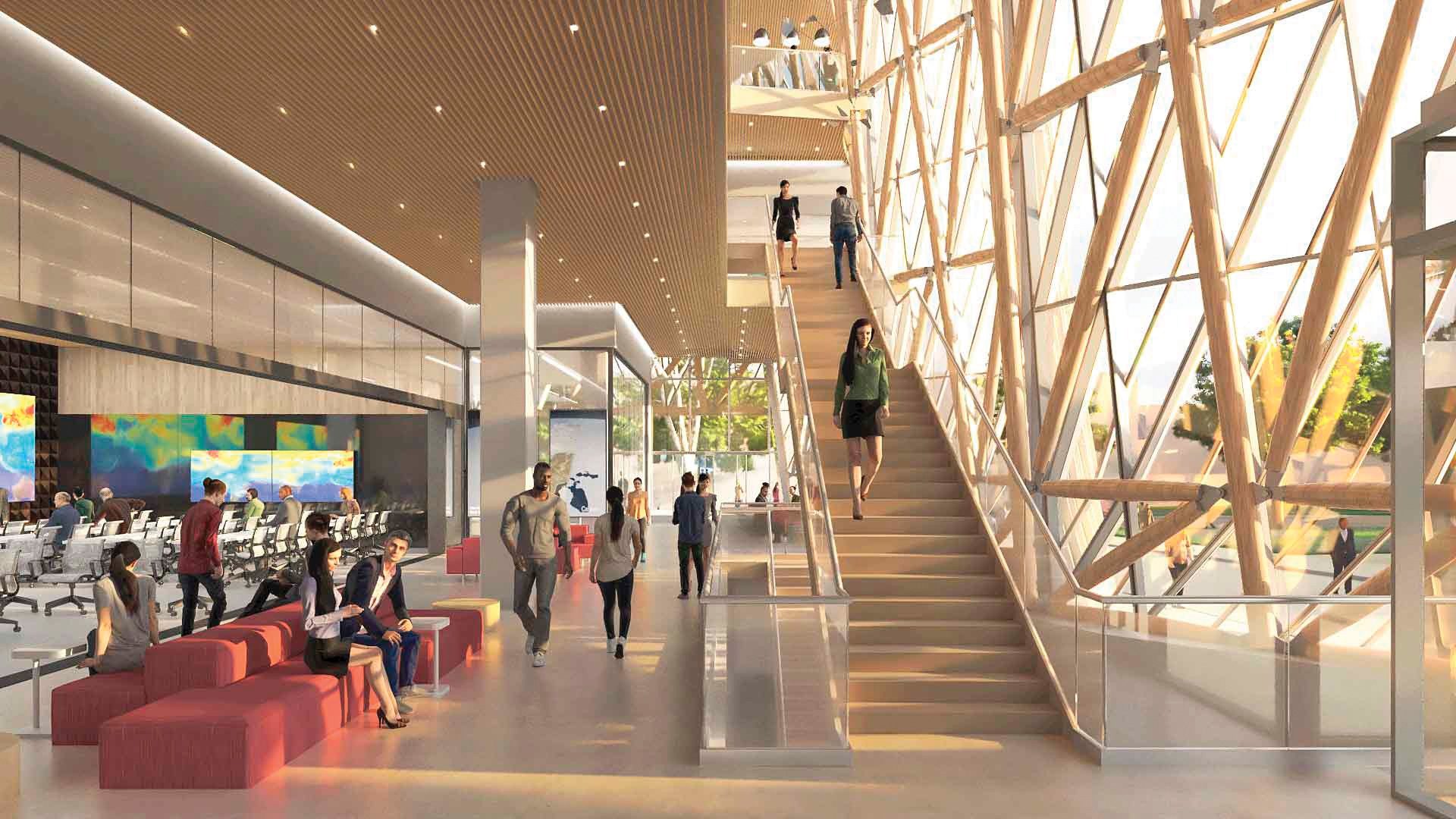
A sustainability research hub at Caltech in Pasadena by Cannon Design's Yazdani Studio relies on such strategies as mass-timber structure and passive-first environmental-control systems.
IMAGE © Yazdani Studio of Cannon Design
The clipping service is one tactic in a firm-wide change-management strategy focused on bringing Cannon’s projects to net zero across the board. Because clients vary widely in terms of their sustainability priorities, the core of Cannon’s “living-centered design” strategy is “a much more empathetic approach to the client,” says Eric Corey Freed, a senior vice president at Cannon and the firm’s director of sustainability. The firm’s “create your own client” playbook guides staff in framing sustainability in terms of client goals generally, and then more specifically, according to three main project types.
Under the umbrella question, “How can you get this client excited about sustainability?” guiding questions are intended to lead to solutions such as a high-performance envelope, healthy materials, alternative structural systems, and embodied-carbon reductions. Among the questions: What are this client’s biggest worries; How can you alleviate these worries; How does your idea connect to other parts of the project; and What are the other benefits your idea brings? The playbook then suggests sector-specific strategies for tying climate-responsive outcomes to client priorities. “So I’m never selling them on a green roof,” says Freed, “I’m selling them on the benefits it provides—biophilia and productivity, thermal mass, a workplace amenity.”
This outcomes-based approach to sustainability begins even before the firm is hired. “I see you’ve committed to carbon neutrality by 2035: how is this project going to help you get there? If you don’t have an answer, we can help.” The approach carries through programming, design, and into construction. “It doesn’t get value-engineered out, because everybody on the team is aware that we’re striving toward these outcomes,” says Freed. “It’s how we’ve been able to get dozens and dozens of clients, all across the country, designing what they’re calling their healthiest building on campus or the greenest building they’ve ever done.”
A standout example, designed by the firm’s Yazdani Studio and now under construction in Pasadena, California, is Caltech’s Resnick Sustainability Resource Center. The 80,000-square-foot mass-timber research hub is designed as a testbed for sustainable strategies: passive-first environmental-control systems (including natural ventilation as the primary mode); sensor- and data-driven building automation; and on-site rainwater management, among other conservation and resilience strategies, with the flexibility to accommodate technological advances as they emerge. Holding together these strategies for what will be the greenest building on Caltech’s campus is a vision of the resource center as a home for the fight to curb climate change.
In summing up Cannon’s approach to conversations with clients about the climate crisis—designing to reduce climate impacts and adapting to the ones that are already inevitable—Freed captures a recurring theme that all of the architects who shared their insights with record expressed: “We don’t see it so much as pushing them as preparing them,” he says. “They come to us for our expertise, and our expertise is telling them they need to prepare for this now.”
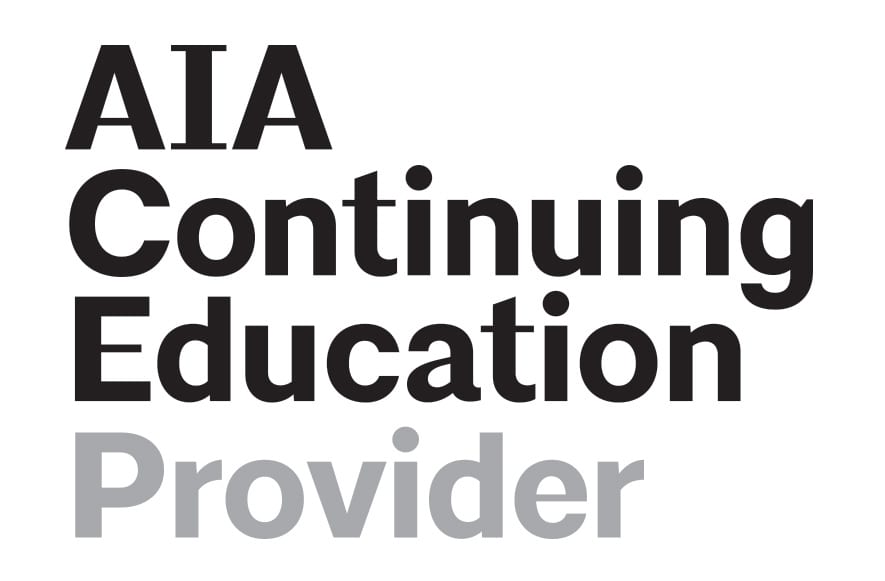
Continuing Education
To earn one AIA learning unit (LU), including one hour of health, safety, and welfare (HSW) credit, read the article above and Creating a Sustainability Action Plan that Works, (The American Institute of Architects, 2021).
Then complete the quiz. Upon passing the quiz, you will receive a certificate of completion, and your credit will be automatically reported to the AIA. Additional information regarding credit-reporting and continuing-education requirements can be found at continuingeducation.bnpmedia.com.
Learning Objectives
- Outline the approaches architecture firms are employing to obtain client support for their environmental goals.
- Define relevant terms such as "carbon offset" and "gap analysis."
- Explain the difference between scope 2 and scope 3 carbon emissions.
- Discuss the implications of focusing environmental goals on carbon emissions rather than energy consumption.
AIA/CES Course #K2204A